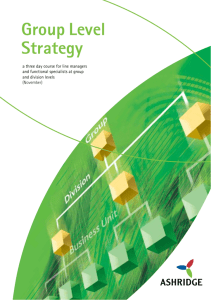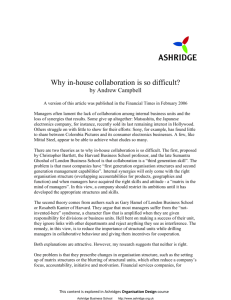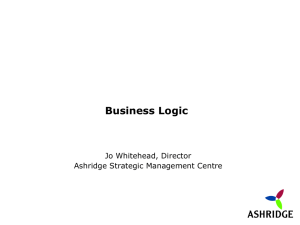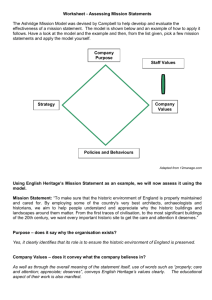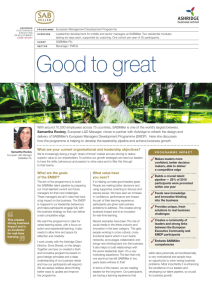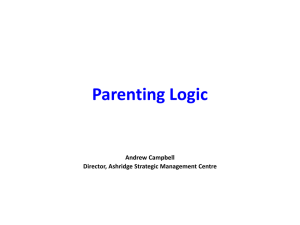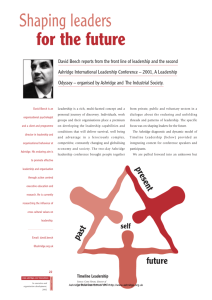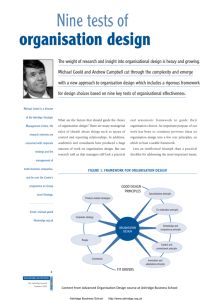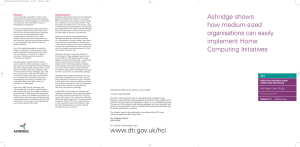Perceptions are not always reality:a review of leadership
advertisement
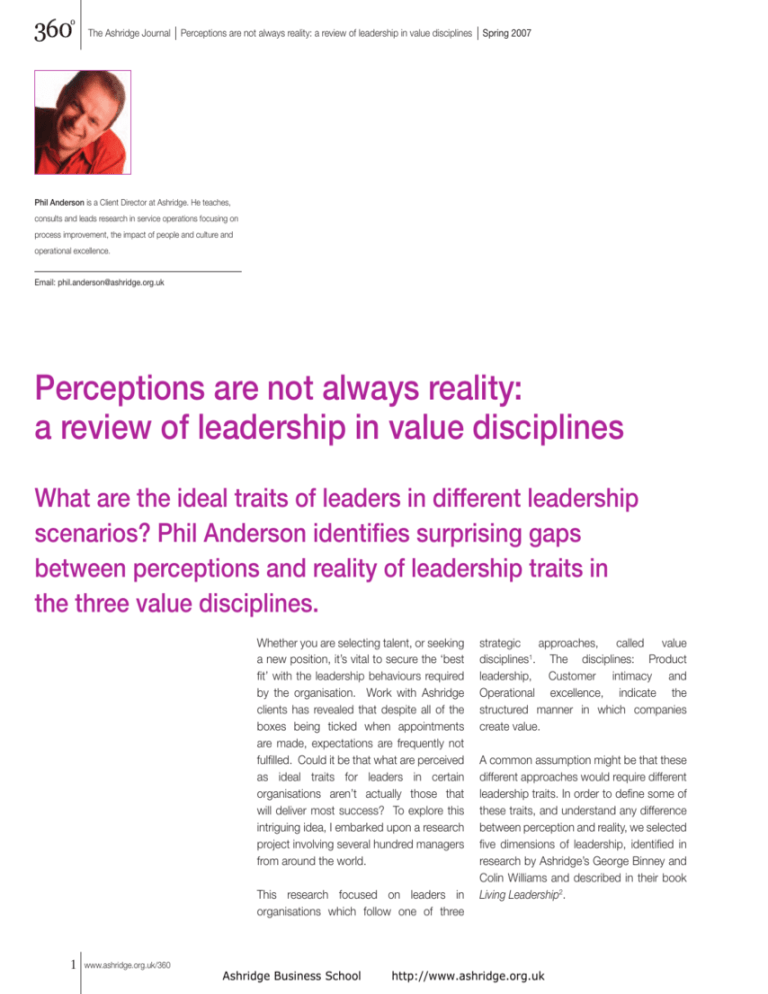
The Ashridge Journal Perceptions are not always reality: a review of leadership in value disciplines Spring 2007 Phil Anderson is a Client Director at Ashridge. He teaches, consults and leads research in service operations focusing on process improvement, the impact of people and culture and operational excellence. Email: phil.anderson@ashridge.org.uk Perceptions are not always reality: a review of leadership in value disciplines What are the ideal traits of leaders in different leadership scenarios? Phil Anderson identifies surprising gaps between perceptions and reality of leadership traits in the three value disciplines. Whether you are selecting talent, or seeking a new position, it’s vital to secure the ‘best fit’ with the leadership behaviours required by the organisation. Work with Ashridge clients has revealed that despite all of the boxes being ticked when appointments are made, expectations are frequently not fulfilled. Could it be that what are perceived as ideal traits for leaders in certain organisations aren’t actually those that will deliver most success? To explore this intriguing idea, I embarked upon a research project involving several hundred managers from around the world. This research focused on leaders in organisations which follow one of three 1 www.ashridge.org.uk/360 Ashridge Business School strategic approaches, called value disciplines1. The disciplines: Product leadership, Customer intimacy and Operational excellence, indicate the structured manner in which companies create value. A common assumption might be that these different approaches would require different leadership traits. In order to define some of these traits, and understand any difference between perception and reality, we selected five dimensions of leadership, identified in research by Ashridge’s George Binney and Colin Williams and described in their book Living Leadership2. http://www.ashridge.org.uk Spring 2007 Theory of value disciplines Based on the premise that organisations cannot deliver successfully to all market segments all of the time, Treacy and Weirsema3 identified three different ways of bringing together a compelling value proposition with an effective operating model: Product leadership – offering their customers the latest in design, technology or service today, tomorrow and in the future through constant innovation – eg Apple, Johnson & Johnson, 3M. Customer intimacy – providing individual solutions to selected clients by building close partnerships and developing strong loyalty – eg Ritz Carlton, First Direct. Operational excellence – delivering quality products or services at the lowest total cost with the least inconvenience and always on time – eg Tesco, Toyota, McDonald’s. Organisations which follow this thinking focus on one of these value disciplines and develop outstanding capabilities in that area. They remain at industry average or above in the other two. Perceptions are not always reality: a review of leadership in value disciplines The Ashridge Journal has been carried out by assessing the average position and approximate spread on each of the dimensions. The results are shown in Figure 1. Collecting the reality data Four companies in the UK and four in Singapore (see Acknowledgements) were selected as good examples of organisations which follow one or other of the value disciplines. Questionnaires were distributed to about 200 leaders and their direct reports. Statistical analysis was conducted on this quantitative data and the conclusions are presented in Figure 1. In the research, for each leadership dimension we offered a continuum along which responses could be made. The dimensions were: Timing: From Waiting and Seeing to Accelerating Progress. Relationships: From Getting Close to Maintaining Distance. Self belief: From Showing Vulnerability to Being Strong. Control: From Keeping Control to Letting Go. Loyalties: From Putting Your Own Needs First to Serving the Organisation. Collecting the perceptions data Over the course of last year I worked with 11 different groups in a variety of workshops and programmes, to understand their perceptions of leadership within the three value disciplines. On each occasion, small groups of participants were invited to work with one of the value disciplines and decide how they would expect leaders in those organisations to behave across five leadership dimensions. Analysis For more detailed descriptions of each of these continua please see www.ashridge. org.uk/research-valuedisciplines Ashridge Business School http://www.ashridge.org.uk www.ashridge.org.uk/360 2 The Ashridge Journal Perceptions are not always reality: a review of leadership in value disciplines The gap between perception and reality Spring 2007 ������ Our discovery has significant implications for leaders choosing their next position and organisations seeking to recruit the right leaders. It appears that in establishing which boxes must be ticked for a certain position, the wrong boxes can often be chosen! There was a considerable discrepancy between perception and reality across all three value disciplines. �������������������� ����������������������� ������������� ��������������� ������������������ ���������������������� ��������� ������������ �������� ������������������� ������������ �������� ����������������������� ������������ �������� ������������������������������ �������������������������� ������� �������������������������������� ������������� �������������������������������� ����������������������������������� ����������������������������� ����������������������������������� ������������������������������� ����������������� ����������� ����������������������� Figure 1. 3 ������������ www.ashridge.org.uk/360 Ashridge Business School http://www.ashridge.org.uk �������������� Spring 2007 Product leadership Most people expect leaders in organisations following this value discipline to encourage progress at every opportunity, allow people to play whilst remaining strong to ensure delivery of profitable innovations to the marketplace. Common belief is that ‘product leaders’ are constantly pushing the boundaries to produce a stream of ‘insanely great products’ (Steve Jobs, CEO of Apple). Therefore, on the leadership dimension of ‘Timing’, one would expect leaders to ‘accelerate progress’ at every opportunity. The reality is somewhat different. Whilst creativity and dynamism are important, delivery is critical. Innovation has been described as ‘the successful exploitation of new ideas’ and therefore ‘waiting and seeing’ how the current set of concepts works is critical. At ?What If! – The Innovation Company, CEO Matt Kingdon is by nature constantly moving. He has no desk, computer or filing cabinet his secondary title of Chief Enthusiast suggests that he’s encouraging others to continually create and yet as he said himself: “I often need to slow down to ensure certain priorities get done.” On a different dimension, the perception data demonstrate that on the continuum of Self belief, ‘being strong’ was commonly expected of leaders in product leadership companies. Perhaps people are influenced by the actions of leaders like Steve Jobs, who, on re-joining Apple in 1996, slashed the number of new products in development from 168 down to three. On the other hand the reality data reveals that leaders spend time sharing their vulnerabilities and discussing their own fallibilities and failures, thereby encouraging others to take some risks. Seah Moon Ming, President of Singapore Technologies Electronics, another of the companies researched, commented: “I encourage lots of trial and error and even argue against myself in front of my colleagues – to try to get them to do the same with me!” Perceptions are not always reality: a review of leadership in value disciplines And finally, the perception and reality data on the ‘control’ leadership dimension also provided some interesting results. Perceptions are built through examples such as I witnessed a few years ago in Nokia’s development facility in Silicon Valley. Here engineers are free to use the games rooms, soft furnished meeting areas and complete Starbucks kitchens to help stimulate their creative juices. Although there is a degree of overlap between the perception and reality here, leaders do need to consider ‘keeping control’ to ensure delivery of results. As Seah Moon Ming said: “There has to be a degree of control on procedures to encourage innovation and to make it happen. After all, the playing around does have to make money at the end of the day.” David Chellew, Director at HSBC Investments, put it: “We have to exercise a degree of control in holding our colleagues back from implementation – all people want to move to the end game as soon as possible.” Matt Kingdon describes it as “freedom within a gilded cage.” In conclusion, reality data suggests that ‘showing vulnerability’ and sharing some past mistakes encourage people to connect to the leader more readily. Yet, commercial pressures ensure leaders maintain control and keep a firm hand on the tiller to avoid overstretch. The Ashridge Journal organisations would behave. They would expect them to build close relationships with both customers and employees: with customers, so that they could respond appropriately to all of their individual requests; and with employees, because contented employees lead to satisfied customers and increased profits, as Heskett et al4 showed with their service profit chain. However, the reality is very different as leaders tend to maintain a certain distance from others. To understand this, one needs to focus on ‘discipline’. Discipline is essential when your job is not merely to meet customer expectations but consistently exceed them. If a customer has been delighted by an employee’s service offering, then it’s essential that you make the time to write a note of appreciation and comment on the incident the next day to the individual and their colleagues. On the other hand, if something has not gone well, effective service recovery with the customer is paramount followed by a robust conversation with the employee. As Joe Levin, Managing Director of the Capital Group put it: “When customers complain – it’s important to ‘deal with it’ as soon as possible. No shocks/surprises in complaints handling. We have to be focused on getting it right. Not getting it wrong. The shame of getting it wrong, is how I feel about it.” Customer intimacy The most consistent views in the entire research were on the leadership dimension of ‘relationships’ in Customer intimate (CI) organisations. Leaders in these environments are expected to build close relationships with both employees and customers and yet the reality suggested something quite different. Other dimensions indicated a large difference in the spread of the data between perceptions and reality for leaders in CI organisations. Most people were very clear about their understanding of how leaders in CI Ashridge Business School http://www.ashridge.org.uk www.ashridge.org.uk/360 4 The Ashridge Journal Perceptions are not always reality: a review of leadership in value disciplines When it comes to the leadership dimension of ‘Timing’, there is no focus in the perception data. Instead, they cover the entire range with the average being somewhat in the middle. This would imply that leaders are expected to be chameleon-like in their approach to timing – being able to hold back or accelerate progress as required by the situation. Typical examples of CI organisations include premium hotels and restaurants, where appropriate responses to customer needs are critical. However, the reality is considerably more focused towards one end of this spectrum – that of ‘accelerating progress’. Both organisations of this type that I visited – the Ritz Carlton Millenia Hotel in Singapore (RCMS) and the Capital – a small, five star boutique hotel in London, felt very strongly that constant change in their product offering is essential. Joe Levin commented: “It’s so important to anticipate people’s needs, so that they don’t say ‘why the hell aren’t you doing this?’…it’s critical to constantly innovate to offer more.” Indeed, on this dimension, CI leaders accelerate progress significantly more than their counterparts in Product leadership. Another leadership dimension with a diverse range of perceptions is that of ‘self belief’. Leaders in these environments are expected to be adaptable: showing their vulnerabilities one moment, whilst remaining strong at another. Here again, the reality data suggests a stronger leaning towards one end of the continuum, in this case ‘being strong’. It was my experience that in this environment, leaders were seen as role models, as people who would never yield whatever the pressures and as individuals who would always be up-beat to motivate those around them. When there are issues, they get resolved: “I will sit down with my managers and we'll discuss a way of resolving an issue. I encourage these views but if there's nothing better, we will do it my way!” – Octavio Gamarra, General Manager of the RCMS. 5 www.ashridge.org.uk/360 Because we have probably all been customers of CI organisations at one time or another, we have developed high expectations of their leaders. The real challenge for them is to ensure they focus on those areas which are important for their personal and organisational success – accelerating progress, being strong and maintaining some distance from their teams. Operational excellence Most people expect very different leadership styles for Customer intimate and Operationally excellent (OE) organisations. It is generally expected that ’keeping control‘ is something OE leaders would be doing at all times, they would ’maintain distance‘ in relationships with employees and would dedicate long hours to their organisations. As can be seen from Figure 1, in reality there is a great deal of similarity between the leadership styles of Operational excellence and those of Customer intimacy. Spring 2007 “Leaders in OE companies should be running an organisation where people move purposefully, where there is a calmness, no chitter-chatter and things work like clockwork. If it’s not like this, then people move to correct it.” – Liak Teng Lit, Chief Executive of Alexandra Hospital in Singapore. Whilst business as usual ticks along, leaders are constantly seeking ways to make things better, simpler and cheaper. A direct report of Tay Soo Meng, Vice President of Network Operations in SingTel, commented on his boss’ approach: “He always encourages his people to learn to find a new way of doing things. Challenges them to do better. Encourages them to ask lots of questions – just like he does himself.” Many of the OE leaders I spoke with said there was so much to do, it was impossible to control everything. Looking more closely at the leadership dimensions for OE, the ‘Control’ dimension displays the biggest gap between perception and reality. The perceptions recorded may be influenced by statements such as: “Our number-to-word ratio is really high” and “Everybody sees everybody else’s numbers… that level of transparency makes it difficult to hide…” – Michael Dell and Kevin Rollins, Chairman and Chief Executive of Dell respectively5. Ryanair’s Michael O’Leary appears to control every penny of his organisation, from preventing employees from charging their mobile phones at work, to making new aircrew pay for their own training and charging customers for every service or drop of water they consume on board! However, once again the reality is very different. With so little time, one might understand why most people held a perception that these leaders would be maintaining their distance when it comes to the ‘relationship’ dimension. Once again, the reality was nearer to the opposite ‘getting close’ end of the continuum. Whether in Tesco Mobile or Tesco stores, the same basic philosophy holds – as Andrew Turner, COO of Tesco Mobile explained: “Another element of the Tesco way is ‘three service expressions: share a smile; know your stuff and show you care’. They're simple and people are encouraged to follow these values.” Furthermore all of the leaders were diligent at keeping close to their employees through either one to one meetings on at least a weekly basis, skip-level meetings every month (eg manager talking to employees two levels down), or simply walking around their departments. Liak neatly summarised his feelings about customers and employees alike: “I don’t believe I’m leading well, if I see grumpy faces on staff and/or patients.” Organisations which are truly operationally excellent have streamlined processes, people who know exactly what to do, and systems that manage variations. And finally, when it comes to the leadership dimension of ‘Loyalties’, it appears that people would expect OE leaders to be the most dedicated to their organisation. Ashridge Business School http://www.ashridge.org.uk Spring 2007 Perceptions like these are most likely borne from images of hard pressed managers in McDonald’s working all hours, retailers at the Dixons group texting their sales figures back every two hours to head office for review, or aircrew on Ryanair preparing to turn their plane around in ten minutes before the next set of passengers comes on board. In reality, it is quite different. My experience of spending time in several Operationally excellent organisations over the years has been that, although the leaders work exceptionally hard during their normal hours, there is a cut-off time, past which they leave to their life outside. Some leaders such as Fatimah, Chief Pharmacist at the Alexandra Hospital, is very aware of her team’s balance of work and life: “I usually hold my meetings in the morning, so that I don’t contact my staff in the evenings. I try to encourage them to have a good work/life balance … I leave it up to them to sort out their projects and their time to do them.” Do hard driving leaders such as Michael O’Leary, Michael Dell and Sir Terry Leahy give operational excellence a bad name? Many managers I’ve spoken with say they wouldn’t want to work in these sorts of companies. If they were to enquire further they’d find a set of leaders who keep a reasonable balance in their lives, build close relationships with their team and Perceptions are not always reality: a review of leadership in value disciplines allow a fair degree of freedom in their work. Furthermore, when looking at the spread of results for the leadership dimensions of these OE companies, you’ll find most people in very close agreement. The Ashridge Journal References 1. Treacy, M and Weirsema, F (1995) The Discipline of Market Leaders, Perseus Books, New York. 2. Binney, George; Wilke, Gerhard and Williams, Colin (2005) Living Leadership – A Practical Guide for Ordinary Heroes, FT Prentice Hall, Harlow, UK. In conclusion If you’ve got your tick boxes ready and you’re about to assess a candidate for a leadership position in your organisation – think again. The discrepancy between the perception and reality of what ’best fit’ might be in each of the three value disciplines, should cause anyone involved in the hiring process to check their assumptions. Boards should consider what really works in their type of organisation, looking closely at which dimensions of leadership are discovered to be important in successful companies in the same value discipline. Pointers such as these will be equally valuable for those seeking positions in companies pursuing one of the three value disciplines. Knowing what works in reality might mean their personal leadership style may be more suitable for a different value discipline than they think. Raised awareness of the findings shared in this article will hopefully contribute to some closing of the gap between perception and reality. Only when the gap is completely closed will leadership appointments have the best chance of success. 3. Op cit 4. Heskett, James L; Jones, Thomas O; Loveman, Gary W; Sasser Jr, Earl W and Schlesinger, Leonard A (1994) Putting the Service-Profit Chain to Work, Harvard Business Review, March-April. 5. Dell, Michael; Rollins, Kevin; Stewart, Thomas, A; O’Brien, Louise; (2005) Execution without Excuses, Harvard Business Review, March Further reading Anderson, Phil and Locke, Malcolm (2005) Jumping off the Service Excellence Bandwagon, 360° – The Ashridge Journal, Spring. Acknowledgements: My thanks to all the leaders who supported this research, particularly those from the following organisations: In Singapore: In the UK: Ritz Carlton Millenia Singapore HSBC Investments Singapore Technologies Electronics Ltd Tesco Mobile SingTel ?What If! – The Innovation Company Alexandra Hospital, Singapore The Capital Group Ashridge Business School http://www.ashridge.org.uk www.ashridge.org.uk/360 6
